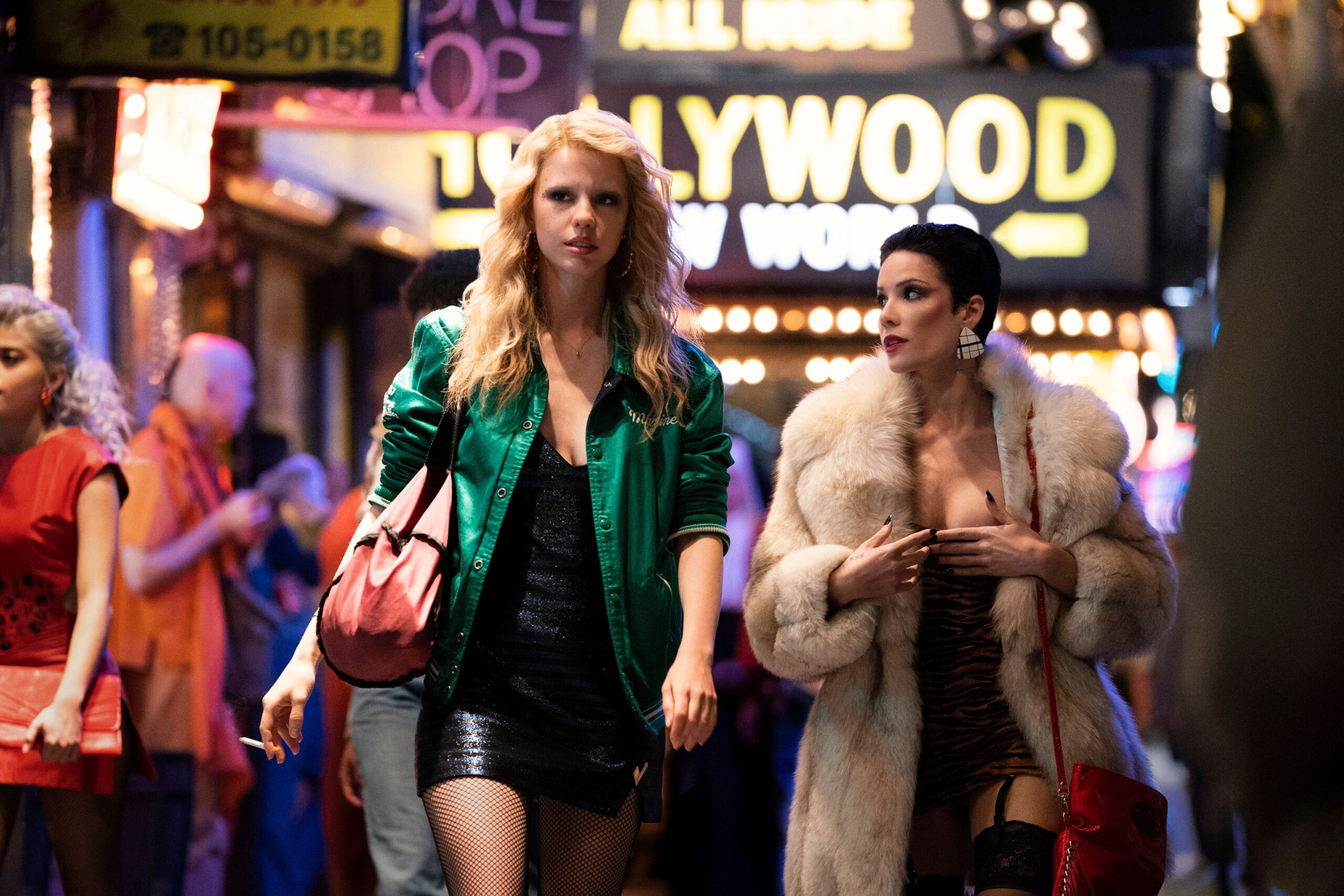‘Maxxxine’: Hollywood Dreams Meet Neon Nightmares in Ti West’s Trilogy Finale

Writer Joseph J. Airdo // Phoenix Film Critics Society
In the neon-drenched, morally ambiguous landscape of 1985 Hollywood, Ti West’s “Maxxxine” brings his X trilogy to a close with a blend of slasher thrills and character-driven drama. While it doesn’t quite reach the heights of its predecessors, this final chapter offers a stylish, engaging conclusion to Maxine Minx’s journey from adult film star to aspiring Hollywood icon.
Mia Goth reprises her role as the ambitious Maxine, now navigating the cutthroat world of mainstream cinema against the backdrop of the real-life Night Stalker murders. Goth’s performance remains a highlight, showcasing Maxine’s evolution from the wide-eyed farm girl of “X” to a more confident, albeit still vulnerable, starlet. However, those expecting the tour de force acting we saw in “Pearl” may be slightly disappointed. While Goth delivers a solid performance, “Maxxxine” lacks the raw, emotionally charged moments that made her previous outings so memorable.
The real revelation here is Kevin Bacon as the sleazy private investigator Labat. Bacon sinks his teeth into the role with relish, delivering a performance that’s as captivating as it is repulsive. From his spot-on Louisiana drawl to his hateful expressions, Bacon creates a character so vividly realized that you can almost smell the stale cigarette smoke and cheap cologne. It’s a career-highlight turn that leaves you wishing for more screen time — or perhaps even a spin-off.
West’s attention to period detail is impeccable, recreating 1980s Hollywood with loving precision. From the neon-lit streets to the gritty backlots, every frame feels authentic to the era. The production design team deserves high praise for their work in bringing this world to life, particularly in scenes set on Hollywood Boulevard and the Universal Studios backlot. A standout sequence involving the iconic “Psycho” house serves as both a thrilling set piece and a loving homage to horror history.
The soundtrack, too, is a triumph. West and his team have curated a selection of ‘80s hits and deep cuts that not only enhance the period feel but also serve the narrative. The use of Frankie Goes to Hollywood’s “Welcome to the Pleasuredome” in a key nightclub scene is particularly effective, capturing both the hedonistic excess and underlying darkness of the era.
While “Maxxxine” is marketed as a horror film, it defies easy categorization. Like its predecessors, it offers more substance than your average slasher, blending elements of psychological thriller, character study, and even dark comedy. The violence, while present, is less extreme than in “X,” though a particular scene of bodily harm may have male viewers crossing their legs in sympathy.
The supporting cast adds depth to the world West has created. Elizabeth Debicki brings a steely determination to her role as director Elizabeth Bender, while Giancarlo Esposito oozes charm and menace as Maxine’s agent, Teddy Knight. Lily Collins makes the most of her brief appearance as reigning scream queen Molly Bennett, embodying both the allure and the disposability of young starlets in the Hollywood machine.
Despite its many strengths, “Maxxxine” feels like it’s missing that special “x-factor” that made “X” and “Pearl” instant classics. The plot, while engaging, lacks truly standout moments that linger in the mind. There’s no equivalent to the creepy midnight encounter from “X” or the devastating eight-minute monologue from “Pearl.” The film’s pacing occasionally lags, particularly in the middle act, as West juggles multiple plot threads and character arcs.
The ending, while fitting for Maxine’s arc, feels somewhat anticlimactic compared to the powerful conclusions of the earlier films. Without spoiling anything, it’s worth noting that some viewers may find themselves wishing for a final twist or a deeper exploration of Maxine’s psychological state after enduring so much trauma.
That said, “Maxxxine” succeeds in tying together themes and motifs from across the trilogy. The recurring mantra “I will not accept a life I do not deserve” takes on new meaning here, as we delve deeper into Maxine’s past and the forces that shaped her relentless ambition. The film also offers commentary on the often-exploitative nature of the entertainment industry, drawing parallels between the adult film world and mainstream Hollywood.
Visually, “Maxxxine” is a feast for the eyes. Cinematographer Eliot Rockett, who has worked with West on all three films, outdoes himself here. The camera work seamlessly shifts from the sun-drenched streets of daytime L.A. to the neon-lit underbelly of the city at night. Several sequences, including a tense chase through the Universal backlot, showcase West’s growth as a visual storyteller.
It’s worth noting that while “Maxxxine” can be enjoyed as a standalone film, viewers will get the most out of it if they’re familiar with “X” and “Pearl.” The trilogy as a whole forms a fascinating exploration of ambition, aging, and the dark side of the American Dream, with each installment offering a different perspective on these themes.
In the end, “Maxxxine” is a solid finale to West’s trilogy. It successfully bridges the gap between the full-on horror of “X” and the psychological drama of “Pearl,” creating a satisfying, if not transcendent, conclusion to Maxine’s story. While it may not reach the heights of its predecessors, it’s still a stylish, well-acted thriller that fans of the series will appreciate.
It’s a testament to West’s vision and Goth’s talent that even as the “weakest” entry in the trilogy, “Maxxxine” still outshines much of what the genre has to offer. As the credits roll, you may find yourself wishing for more time in this meticulously crafted world — and perhaps wondering what other stories West might have up his sleeve.




